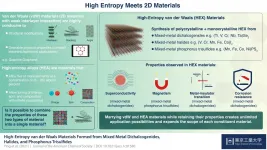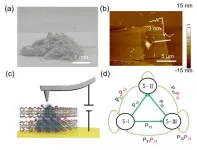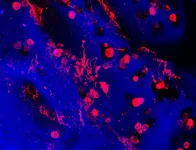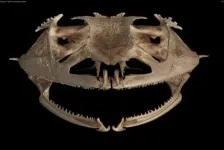Researchers develop proof-of-concept treatment that elevates adult and fetal hemoglobin
CHOP study shows vector developed to treat blood disorders could simultaneously reactivate fetal hemoglobin, suppress mutant adult hemoglobin, and supply functional adult hemoglobin
2021-06-01
(Press-News.org) Philadelphia, June 1, 2021--Researchers at Children's Hospital of Philadelphia (CHOP) have developed a proof-of-concept treatment for blood disorders like sickle cell disease and beta-thalassemia that could raise hemoglobin levels by activating production of both fetal and adult hemoglobin. Using a viral vector engineered to reactivate fetal hemoglobin production, suppress mutant hemoglobin, and supply functional adult hemoglobin, the researchers developed an approach that could produce more hemoglobin through a single vector. The results were published in Haematologica.
"Until now, researchers have been exploring one of two approaches to treating blood disorders like sickle cell disease or beta-thalassemia: adding a functional copy of the adult hemoglobin gene, or increasing production of fetal hemoglobin," said senior author Stefano Rivella, PhD, Kwame Ohene-Frempong Chair on Sickle Cell Anemia and Professor of Pediatrics at CHOP. "In this study, we have done both simultaneously, which provides an opportunity to produce more hemoglobin per vector in these patients."
Sickle cell disease and beta-thalassemia are genetic blood disorders caused by errors in the genes for hemoglobin, a protein that is found in red blood cells and carries oxygen from the lungs to tissues throughout the body. In utero, the gamma-globin gene produces fetal hemoglobin, but after birth, this gene is switched off and the beta-globin gene is turned on, producing adult hemoglobin. Patients with sickle cell disease and beta-thalassemia have mutations in the beta-globin gene, which leads to mutant hemoglobin production and, as a consequence, serious health complications, ranging from delayed growth and jaundice to pain crises, pulmonary hypertension, and stroke.
Current research has focused on treating these blood disorders by either increasing fetal hemoglobin, which is not mutated in these conditions, or adding back a functional copy of adult hemoglobin via gene therapy, using an engineered vehicle known as a viral vector to supply new genetic material. However, there are limitations to both of these approaches, and neither has been established as a fully curative approach.
In order to increase hemoglobin levels in one therapy, the researchers - led by co-first authors Danuta Jarocha, PhD and Silvia Lourenco, PhD - combined the two tactics into a single gene therapy vector. To do so, they focused on a transcription factor called BCL11A, which effectively operates the switch that turns off the production of fetal hemoglobin and turns on the production of adult hemoglobin. The researchers hypothesized that if they could use an engineered vector to repress BCL11A, which would keep fetal hemoglobin production turned on and turn off the production of mutant adult hemoglobin, while also adding back a functional copy of the beta-globin gene, they could induce greater hemoglobin production.
Working in cell lines of patients with sickle cell disease and beta-thalassemia, the researchers tested their vector - which included a gene coding for adult hemoglobin and a microRNA sequence that would target BCL11A - and found that the vector was able to elevate fetal and adult hemoglobin simultaneously in vitro. Although BCL11A was not completely knocked down, the suppression was sufficient to reduce production of the mutant adult hemoglobin. By elevating both fetal and functional adult hemoglobin, the vector was able to induce more functional hemoglobin production than that of a vector expressing beta-globin alone.
"Future studies will evaluate this approach using an even stronger vector that we developed in our lab and published on recently," Rivella said. "Combining these two technologies, we hope to make an even more powerful vector that can provide curative levels of hemoglobin to these patients."
This research was supported by the CuRED Frontier Program at CHOP, which is dedicated to finding new and improved curative therapies for blood disorders like sickle cell disease and beta-thalassemia.
INFORMATION:
Lourenco et al. "Inclusion of a shRNA targeting BCL11A into a beta-globin expressing vector allows concurrent synthesis of curative adult and fetal hemoglobin," Haematologica, online May 27, 2021, DOI: 10.3324/haematol.2020.276634
About Children's Hospital of Philadelphia: Children's Hospital of Philadelphia was founded in 1855 as the nation's first pediatric hospital. Through its long-standing commitment to providing exceptional patient care, training new generations of pediatric healthcare professionals, and pioneering major research initiatives, Children's Hospital has fostered many discoveries that have benefited children worldwide. Its pediatric research program is among the largest in the country. In addition, its unique family-centered care and public service programs have brought the 595-bed hospital recognition as a leading advocate for children and adolescents. For more information, visit http://www.chop.edu
[Attachments] See images for this press release:
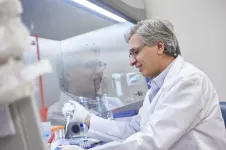
ELSE PRESS RELEASES FROM THIS DATE:
2021-06-01
The discovery of graphene, a 2D layered form of carbon, once caused a paradigm shift in science and technology like no other. As this wonder material drew attention from material scientists around the world, it spurred research on other materials that were structurally similar, such as "van der Waals materials", which comprise strongly-bonded 2D atomic layers that are held together by weak interlayer interactions called "van der Waals forces". These materials quickly caught on because they were highly conducive to structural modifications, such as stacking, twisting, and insertion of foreign molecules between layers, which gave them interesting physical properties ...
2021-06-01
Getting enough sleep can be a real challenge for shift workers affecting their overall health. But what role does being an early bird or night owl play in getting good rest? Researchers from McGill University find a link between chronotype and amount of sleep shift workers can get with their irregular schedules.
"Some people seem to be hardwired to sleep early, while others tend to sleep late. This preference, called chronotype, is modulated by our circadian system - each person's unique internal timekeeper," says lead author Diane B. Boivin, a Professor in the Department of Psychiatry at McGill University.
Their study published in Sleep is the first to examine the relationship between ...
2021-06-01
Algorism plays a significant role in predicting future states of a system. Particularly, non-Markov chain algorithm has been widely applied in epidemic spreading processes, social and man-made memory networks, the environment-related quantum entangled states, and artificial algorisms such as face pose tracking. Traditionally, a large number of memories and computing cells are integrated to achieve these goals by software algorisms, showing high complexity. In the paper published in Science Bulletin, a group led by Bilu Liu and Hui-Ming Cheng from Tsinghua-Berkeley Shenzhen Institute (TBSI) of Tsinghua University has realized a non-Markov chain algorithm in a single resistive random access memory (RRAM) based on 2D mineral material ...
2021-06-01
Swedish researchers from institutions including Uppsala University have spent four years gathering data from the areas affected by the major forest fire of 2014. In their study of how the ecosystem as a whole has been altered, they could see that water quality in watercourses quickly returned to normal, while forested areas continued to lose carbon for many years after the fire.
The consequences of major forest fires remain poorly studied in Northern Europe. To improve this situation, researchers from Uppsala University, the Swedish University of Agricultural Sciences (SLU) and the Swedish Meteorological ...
2021-06-01
Siberian jays are group living birds within the corvid family that employ a wide repertoire of calls to warn each other of predators. Sporadically, however, birds use one of these calls to trick their neighbouring conspecifics and gain access to their food. Researchers from the universities of Konstanz (Germany), Wageningen (Netherlands), and Zurich (Switzerland) have now examined how Siberian jays avoid being deceived by their neighbours. The study, published in the journal Science Advances, shows that these birds have great trust in the warning calls from members of their own group, but mainly ignore such ...
2021-06-01
News media reports about scientific failures that do not recognize the self-correcting nature of science can damage public perceptions of trust and confidence in scientific work, according to findings by researchers at the Annenberg Public Policy Center (APPC) of the University of Pennsylvania and the University at Buffalo, the State University of New York.
News stories about science follow several specific narratives, the researchers write in a new study in the journal Public Understanding of Science. One is that science is "in crisis" or "broken," a narrative driven in recent years by reports of unsuccessful efforts to replicate findings in ...
2021-06-01
A new miniature 3D model of human bone marrow has been described today in the open-access eLife journal.
The model may help clinicians predict which patients will benefit from a new therapy for blood platelet disorders, such as Inherited Thrombocytopenias - a group of familial disorders that inhibit the production of platelets. It could also enable further study of these disorders and give scientists a new tool to test experimental treatments.
Platelets are cells that are necessary for the blood to clot and stop bleeding. Having too few platelets can lead to internal or serious bleeding after surgery or injuries, which is usually treated with therapies that cause clotting. Recent studies have shown that a drug called Eltrombopag increases ...
2021-06-01
A college education is estimated to add $1 million to a person's lifetime earning potential, but for some students the path to earning one is riddled with obstacles. That journey is even more difficult for students who have been in the foster care system or experienced homelessness, according to a new study from the University of Georgia.
But the more college administrators and faculty know about these students' problems, the more they can do to ease the burden.
Getting into universities in the first place can frequently be a challenge for students who've had unstable home lives, said David Meyers, co-author of the study.
"Research tells us that every time a student moves from one foster care placement to another, they lose six months of educational ...
2021-06-01
In recent months, more than three hundred cases of salmonellosis have occurred in various European countries and Canada, which are linked to each other. In the UK the cases could be partly traced back to frozen breaded poultry meat. The cause was contamination with the bacterium Salmonella Enteritidis, which causes gastrointestinal inflammation. Salmonella is not killed by deep freezing and can remain infectious at temperatures below zero degrees Celsius. The Robert Koch Institute (RKI) and the BfR are monitoring the situation together with the Federal Office of Consumer Protection and Food Safety (BVL). In Germany, the number of reported cases has currently ...
2021-06-01
GAINESVILLE, Fla. --- Scientists have long known that frogs are oddballs when it comes to teeth. Some have tiny teeth on their upper jaws and the roof of their mouths while others sport fanglike structures. Some species are completely toothless. And only one frog, out of the more-than 7,000 species, has true teeth on both upper and lower jaws.
Now, the first comprehensive study of tooth evolution in frogs is bringing the group's dental history into focus. Florida Museum of Natural History researchers analyzed CT scans of nearly every living amphibian genus to reveal that frogs have lost teeth over 20 times during their evolution, more than any ...
LAST 30 PRESS RELEASES:
[Press-News.org] Researchers develop proof-of-concept treatment that elevates adult and fetal hemoglobin
CHOP study shows vector developed to treat blood disorders could simultaneously reactivate fetal hemoglobin, suppress mutant adult hemoglobin, and supply functional adult hemoglobin

